One of the most captivating and historically significant attractions in Hampi, the Hazara Rama Temple (also referred to as the Hazara Ramachandra Temple) stands as a testament to the architectural brilliance of the Vijayanagara Empire. Located within the Royal Enclosure, this temple holds immense cultural and religious significance. “Hazara Rama” translates to “a thousand Rama,” signifying the temple’s dedication to Lord Rama and depicting the epic Ramayana through its intricate carvings.
Hazara Rama Temple is situated in the northeastern part of Hampi. It’s approximately 3 Kilometers from the Hampi Bus Stand. You can walk or hire an autorickshaw or rent a bicycle to get there.

Table of Contents:-
The Hazara Rama Temple in Hampi is a treasure trove of history, art, and spirituality. Its intricate carvings, depicting the tales of Lord Rama and the grandeur of the Vijayanagara Empire, make it a must-visit destination for history enthusiasts, architecture aficionados, and spiritual seekers alike. A visit to the temple is a journey back in time, where you can witness the glory of a bygone era and experience the timeless beauty of India’s cultural heritage.
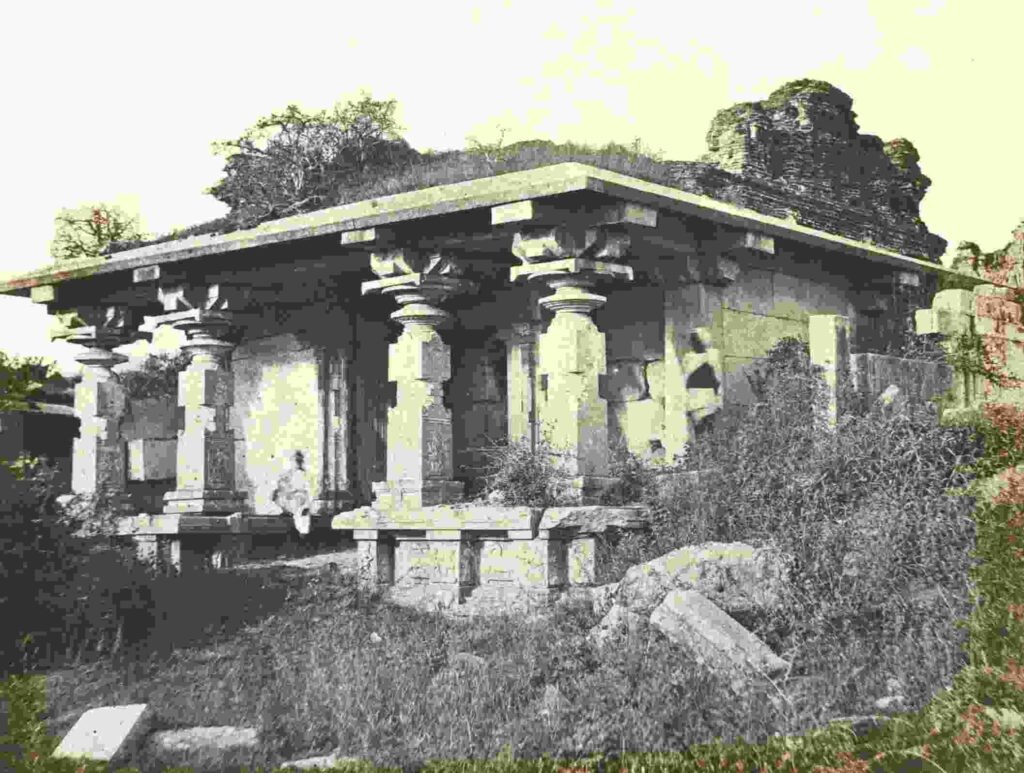
Quick Facts
- Timing: 06:00 AM to 06:00 PM
- Entry Fee: No entry fee required
- Photography: Allowed
- Location: Google Maps
- Must-See Attractions
Historical Significance
The Hazara Rama Temple’s historical legacy is deeply rooted in the annals of Vijayanagara history. The earliest reference to this temple dates back to an inscription dated to 1416 CE referring to a grant by Queen Annaladevi.[1] It is believed to have been constructed in the early 15th century by King Devaraya II.[2] This patronage by the Vijayanagara royalty underscores the temple’s importance as a center of religious and cultural patronage during the empire’s zenith.
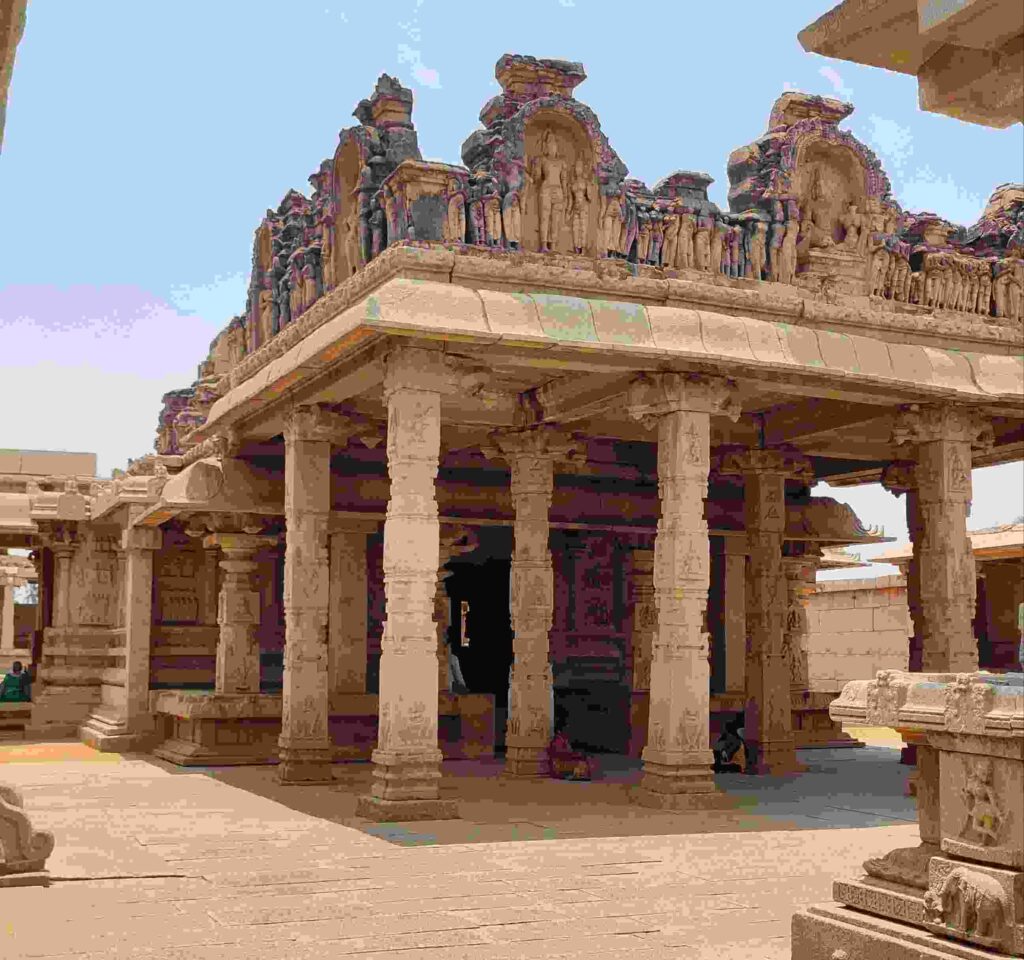
During its heyday, the temple flourished as a focal point of Vijayanagara’s spiritual and cultural life, receiving royal patronage and support from successive rulers. The inscriptions bear witness to the temple’s significance as a place of worship and pilgrimage, attracting devotees from far and wide to pay homage to Lord Rama. Additionally, the temple’s architectural marvels and intricate carvings reflect the artistic and religious fervor of the Vijayanagara era, leaving a lasting imprint on Hampi’s cultural landscape.
Today, as visitors explore the Hazara Rama Temple, they are transported back in time to an era of grandeur and devotion, where kings and queens walked the hallowed halls in reverence. The temple’s rich historical legacy serves as a reminder of Hampi’s glorious past and its enduring cultural heritage, continuing to inspire awe and admiration among all who visit.
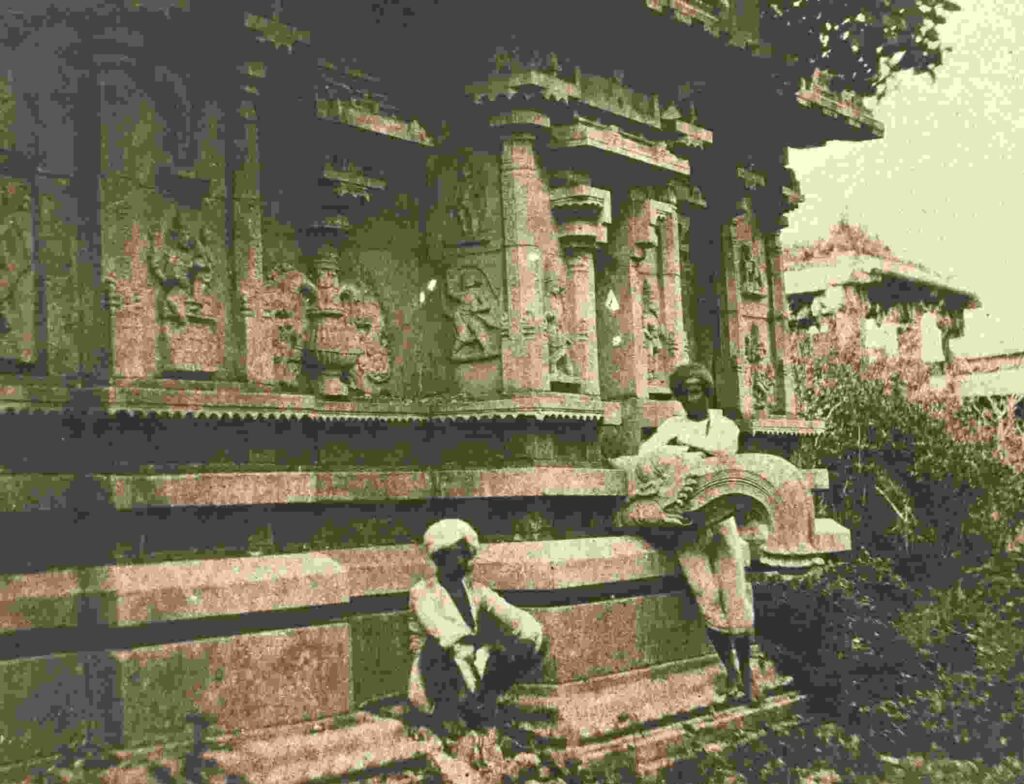
Architectural Grandeur
The Hazara Rama Temple’s architectural plan follows the traditional Dravidian style, offering a beautiful example of this South Indian architectural tradition. The eastern facing temple features a garbhagriha (sanctum), antarala (antechamber), a rangamandapa (pillared hall) with three entrances, and a spacious pillared porch. The pillars of the rangamandapa are made of polished schist stone and are decorated with twelve sculpted panels depicting Vishnu’s avatars. A separate, more ornate shrine dedicated to Devi (the goddess) is located at the northwest corner.

The main temple and the Devi shrine are adorned with typical Dravidian shikharas (superstructures) adding an air of grandeur. Pillared cloisters flank the west and southeast sides, and the entire complex is enclosed within a prakara (enclosure) wall. Gateways on the east and north and a passage entrance on the south provided access to the temple grounds in days gone by.
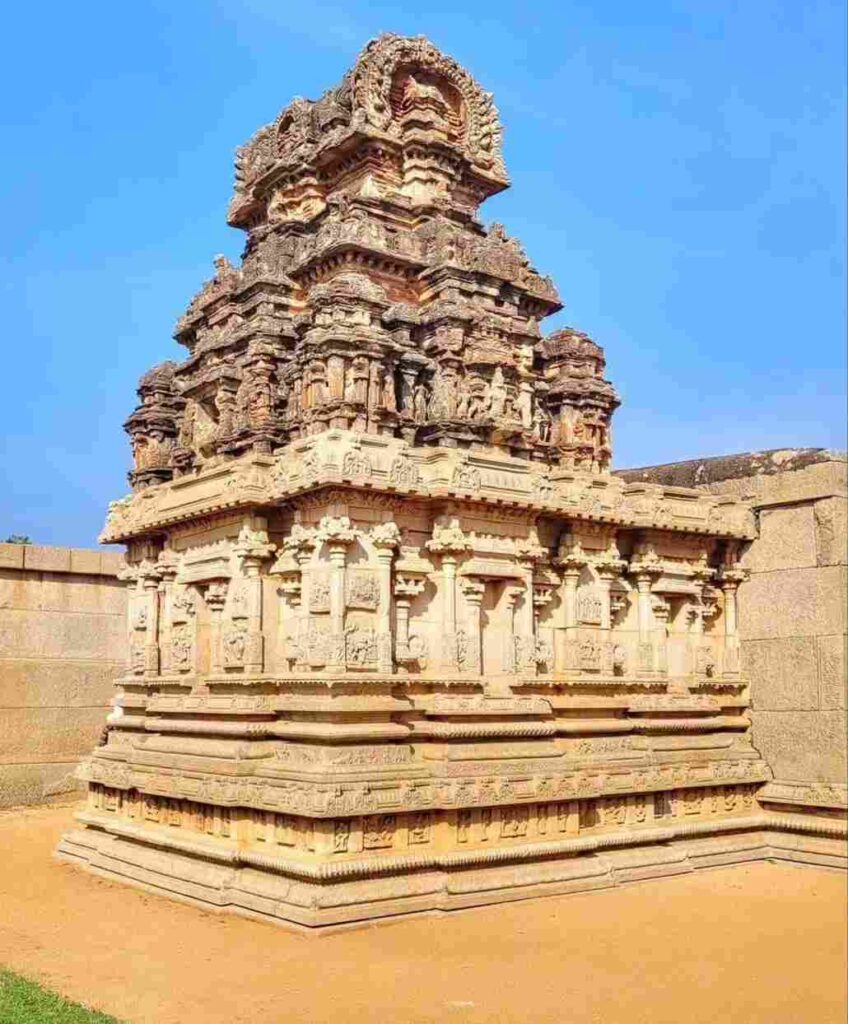
The Vijayanagara Kings’ Private Temple
The Hazara Rama Temple might not be the most massive structure in Hampi, but its location and intricate details reveal a fascinating story. Situated within the heart of the Royal Enclosure, the core of the empire’s capital city, the temple is believed to have served as a private sanctuary for the Vijayanagara kings and their families. Imagine the rituals and prayers that would have filled this space, a place of solace and devotion for the royal family.
Imagine the scene within the temple walls centuries ago—a tranquil haven where the Vijayanagara kings and their loved ones sought solace and offered their devotion to Lord Rama. Enclosed within the bustling capital, the temple provided a serene retreat from the demands of court life, fostering a deep connection to spirituality and tradition. The temple’s architecture, adorned with exquisite carvings and sculptures, stands as a testament to the artistic prowess and religious fervor of the Vijayanagara era.
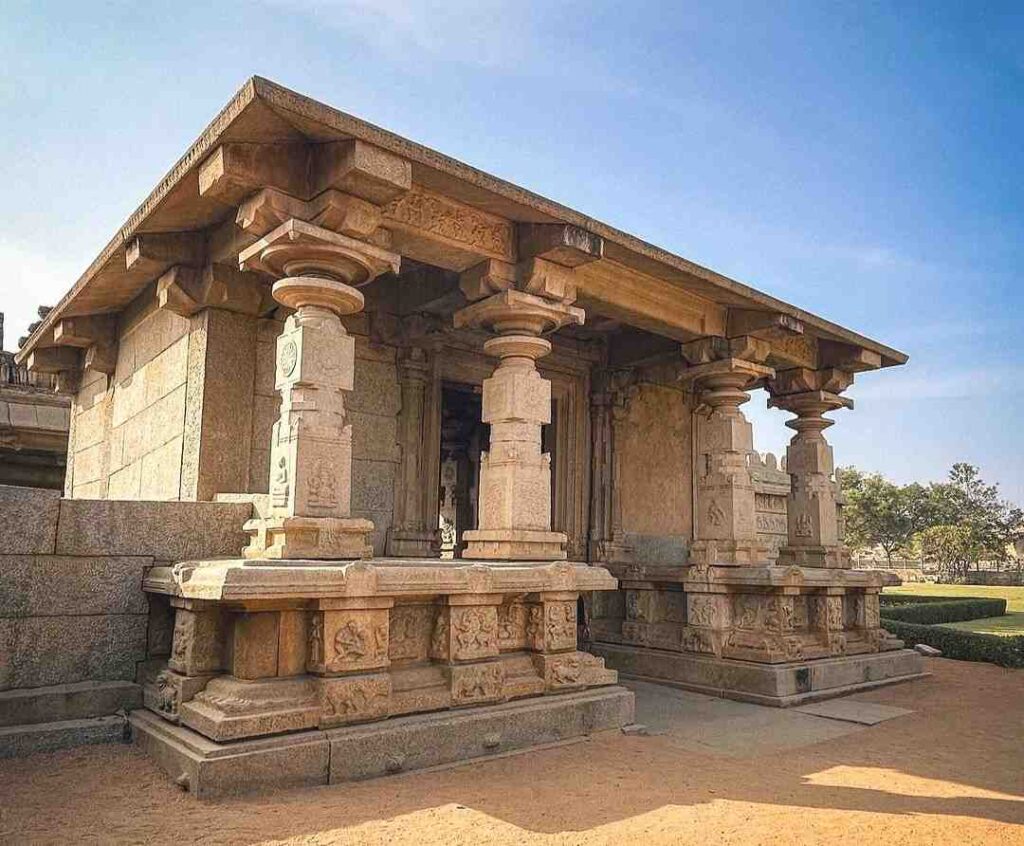
A Visual Ramayana Unfolds
The true magic of the Hazara Rama Temple unfolds on its outer walls. Imagine these walls as a giant canvas, meticulously carved from stone. Each panel tells a story, transporting you on a visual journey through the Ramayana. Witness the valiant Rama’s exile to the forest, the abduction of Sita by the ten-headed Ravana, the epic battle between Rama and Ravana, and Rama’s triumphant return to Ayodhya.
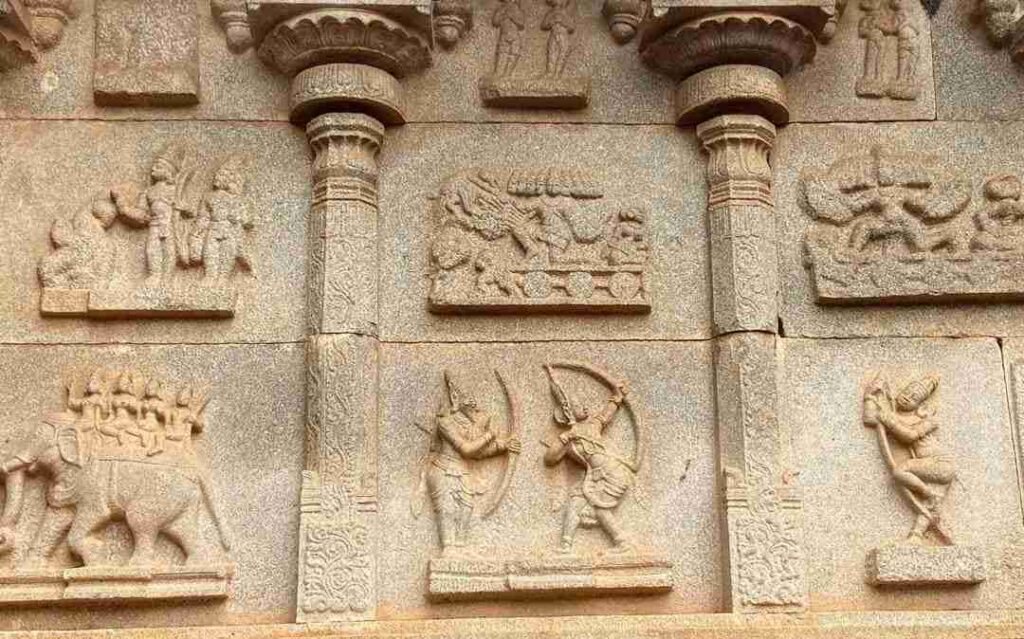
The artistry is remarkable. The expressions on the characters’ faces, the intricate details of clothing and weaponry, and the depiction of emotions like grief, valor, and devotion leave you awestruck. These carvings are not just decorative; they are a powerful storytelling medium, keeping the Ramayana alive for generations to come.
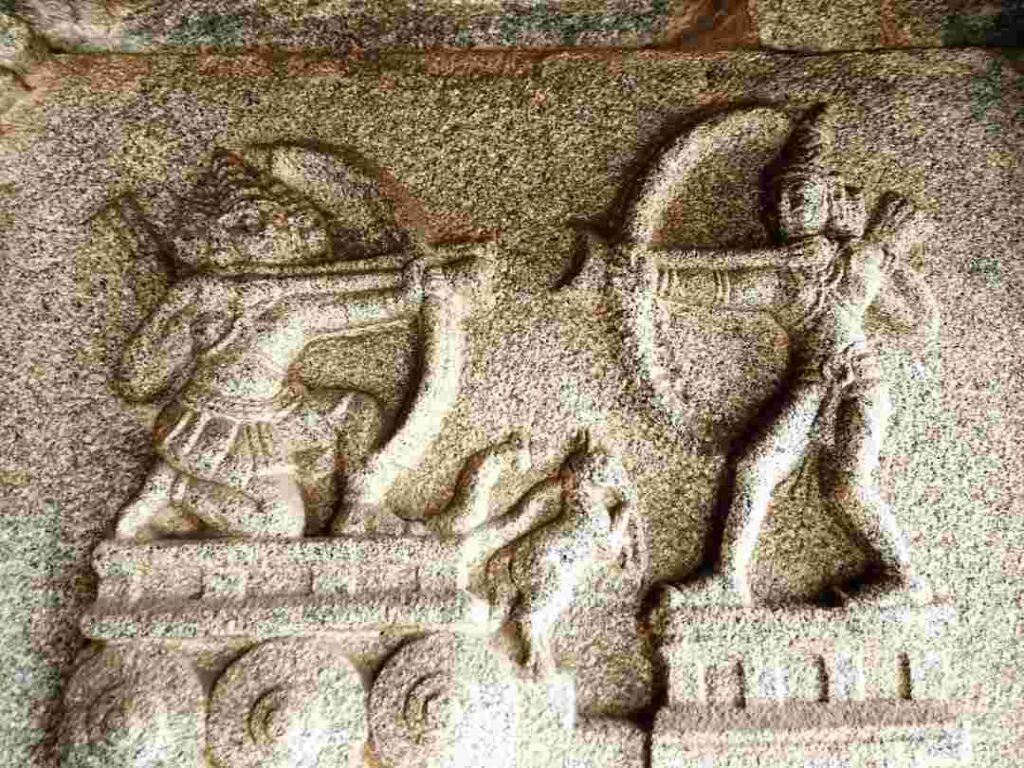
Beyond the Epic:
While the Ramayana takes center stage, the temple walls showcase a broader narrative. You’ll find depictions of royal processions, a glimpse into the grandeur of the empire with elephants and soldiers marching in order. Look closely, and you might spot musicians playing instruments, dancers in graceful poses, and even scenes of everyday life from the Vijayanagara era. These carvings offer a window into the social and cultural tapestry of the empire, giving you a sense of the people who lived, worshipped, and celebrated within the city’s walls.
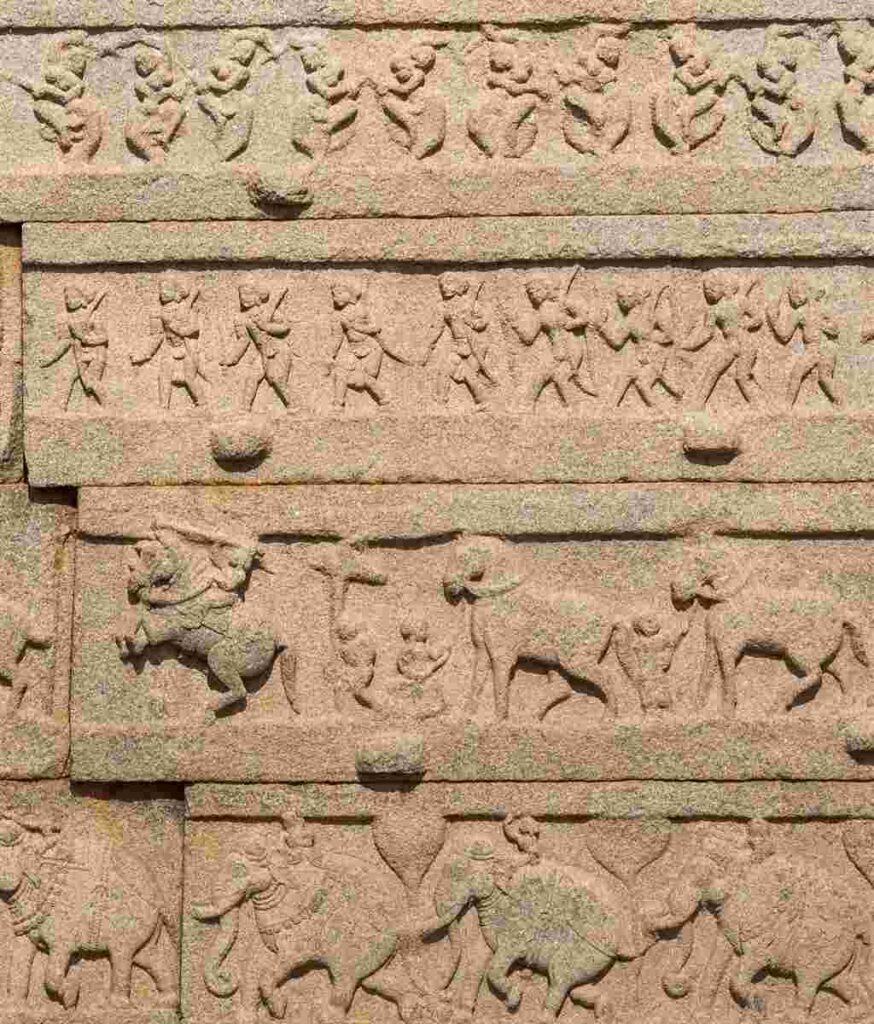
Uniquely Decorated Walls
The exterior walls of the prakara are what truly set the Hazara Rama Temple apart. Unlike most temples in the capital city, these walls are not bare. Instead, they are adorned with a captivating display of bas-reliefs depicting horses, elephants, camels, dancing girls, stick dances, musicians, and various other scenes. These intricate carvings offer a vivid snapshot of daily life, entertainment, and celebrations during the Vijayanagara era.
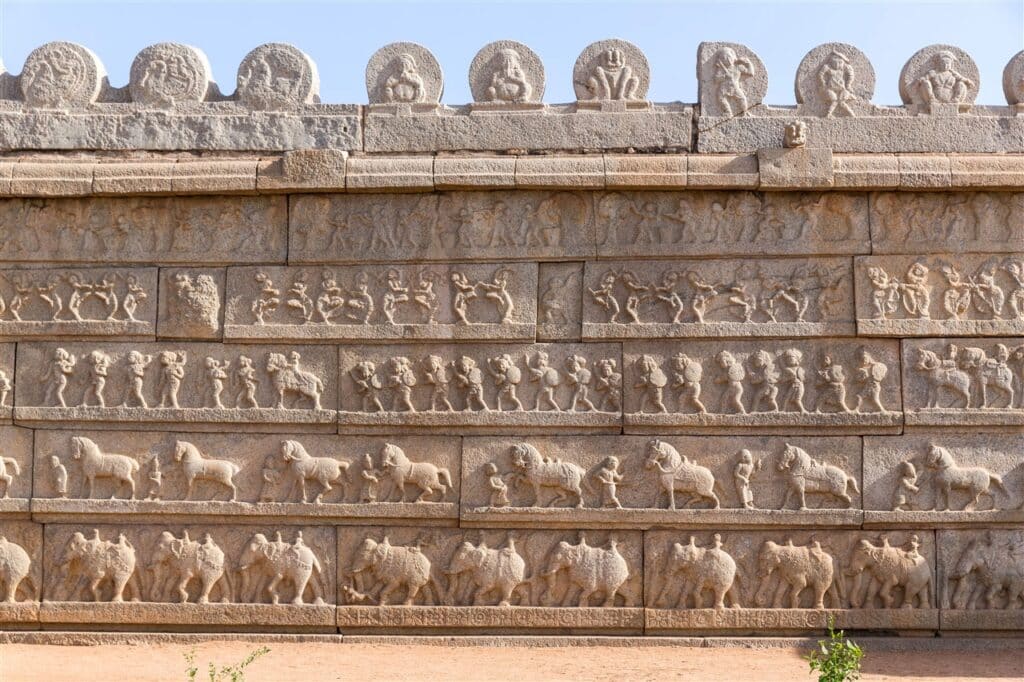
As you gaze upon these remarkable bas-reliefs, you can’t help but imagine the vibrant festivals and joyous occasions that once filled the temple complex. The lively depictions of dancers, musicians, and festive processions transport you back in time to an era of cultural vibrancy and artistic splendor. Each carving is a testament to the skill and creativity of the artisans who brought these scenes to life, enriching the temple’s ambiance with their enduring legacy.
For visitors, the uniquely decorated walls of the Hazara Rama Temple offer more than just a visual spectacle; they provide a window into the rich tapestry of Vijayanagara life. Whether you’re an art enthusiast, a history buff, or simply curious about the past, these carvings invite you to explore and appreciate the cultural heritage of Hampi in all its colorful glory.
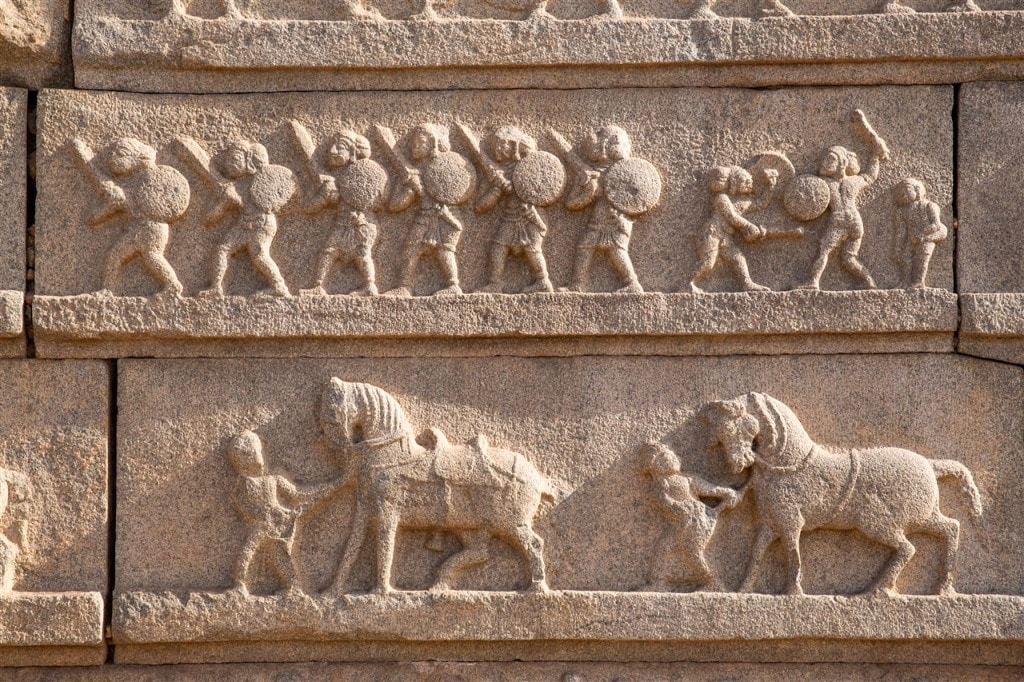
Two Small Wells and Rainwater Canals
Within the Hazara Rama Temple complex, visitors can discover two small wells that were once vital sources of water for the temple and its devotees. These wells, though modest in size, hold historical significance as they provided water for various rituals and ceremonies conducted within the temple premises.
Additionally, small canals are strategically placed around the temple to collect rainwater, ensuring that the sacred space remained hydrated throughout the year. These canals served a practical purpose, helping to channel rainwater away from the temple and prevent flooding, while also replenishing the wells and sustaining the surrounding landscape.
The presence of these wells and canals highlights the thoughtful architectural planning of the temple complex, showcasing the ingenuity of ancient engineering techniques used to manage water resources in Hampi’s arid climate. Today, they stand as reminders of the temple’s functional and spiritual importance in the daily lives of its worshippers.
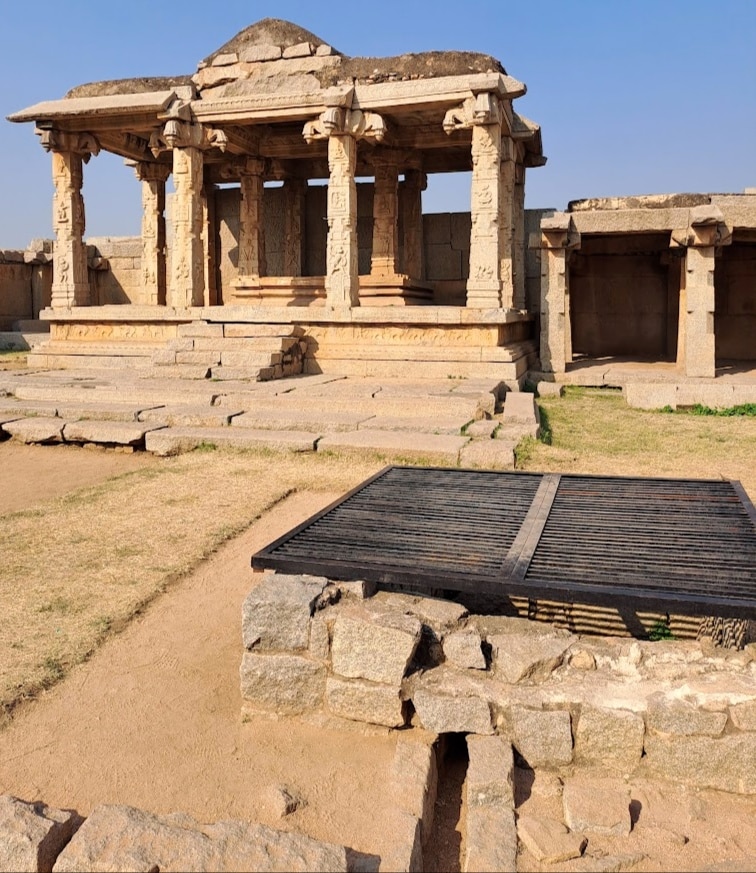
A Spiritual and Cultural Experience
Visiting the Hazara Rama Temple is not merely about admiring its architectural grandeur; it is a spiritual and cultural journey that immerses you in India’s rich heritage. Stepping into the temple’s serene ambiance offers a respite from the bustling world outside, allowing you to connect with the aura of devotion and reverence that pervades the air.
As you wander through the temple’s sacred halls, adorned with intricate carvings and sculptures depicting scenes from Hindu mythology, you can feel the presence of centuries of history and tradition. Each detail tells a story, from the royal patronage inscribed on the temple walls to the rituals performed by devotees over the ages.
For many visitors, the Hazara Rama Temple is not just a stop on a sightseeing tour; it is a place where they can immerse themselves in the cultural and artistic legacy of Vijayanagara. Whether you come to marvel at its architectural marvels or to meditate in its tranquil surroundings, the temple offers a profound experience that transcends time and space, connecting you to the essence of India’s cultural heritage.

The Legend of Lord Rama: A Timeless Epic Etched in Stone at Hazara Rama Temple
The Hazara Rama Temple in Hampi is more than just a captivating monument; it’s a visual narrative that unfolds the legendary tale of Lord Rama. This beloved Hindu epic, the Ramayana, isn’t just a story – it’s a cornerstone of Indian culture, deeply woven into the fabric of society. Here’s a glimpse into the legend that adorns the walls of the Hazara Rama Temple:
Rama: The Ideal King and Divine Prince
Rama, the central figure of the Ramayana, is revered as the embodiment of righteousness, courage, and unwavering devotion. He was the eldest son of King Dasharatha of Ayodhya, a kingdom renowned for its prosperity and just rule. The carvings on the temple walls depict Rama’s idyllic childhood, his training in warfare and statecraft, and his rise as a prince admired by all.
Love and Betrayal: The Abduction of Sita
The story takes a dramatic turn when Rama is chosen as heir apparent. However, palace intrigue and a twist of fate lead to Rama being exiled to the forest for fourteen years along with his devoted wife Sita and his loyal brother Lakshmana. Their idyllic life in the forest is shattered when the ten-headed demon king Ravana abducts Sita, captivated by her beauty.
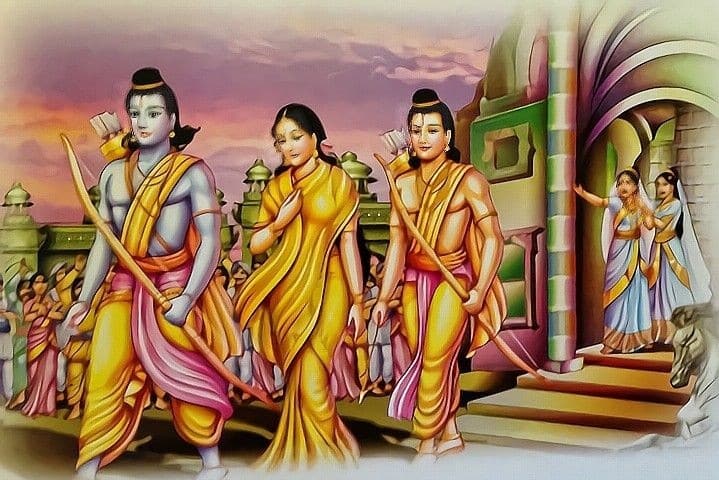
The Quest for Justice: The Battle Between Good and Evil
Rama embarks on a perilous quest to rescue Sita, forging alliances with monkey warriors led by the valiant Hanuman. The epic battle between Rama and Ravana is a central theme depicted on the temple walls. Witness Rama’s unwavering determination, the power of his arrows, and the ultimate triumph of good over evil as Ravana falls.
A Return to Ayodhya and a Legacy Etched in Time
After rescuing Sita and facing trials by fire to prove her purity, Rama finally returns to Ayodhya. The jubilant celebrations of his coronation as king mark the culmination of the epic tale. The carvings at the Hazara Rama Temple not only showcase the events of the Ramayana but also highlight the values it upholds – the importance of family, the power of loyalty, the triumph of dharma (righteous duty), and the ultimate victory of good over evil.
Must-see attractions at Hazara Rama Temple
Discover the must-see attractions at the Hazara Rama Temple in Hampi and immerse yourself in its rich history and architectural marvels. Here are some of the top attractions you shouldn’t miss:
The Ramayana Etched in Stone:
The temple’s defining feature is undoubtedly the intricate carvings adorning the outer walls. These panels depict scenes from the epic Ramayana, showcasing Rama’s exile, the abduction of Sita, the epic battle with Ravana, and the triumphant return to Ayodhya. Imagine these walls as a giant canvas, transporting you back in time through the legendary tale.
Pillared Hall (Rangamandapa):
Explore the pillared hall of the temple, known as the Rangamandapa, adorned with polished schist stone pillars featuring sculpted panels depicting various avatars of Lord Vishnu.
Devi Shrine:
Visit the separate shrine dedicated to Devi, located within the temple complex, and observe the ornate carvings and Dravidian shikharas (superstructures) adorning the shrine.
Outer Prakara Walls:
Take a leisurely stroll around the temple’s outer prakara walls and admire the bas-reliefs depicting horses, elephants, camels, dancing girls, and other scenes from daily life during the Vijayanagara era.
Water Wells and Canals:
Discover two small wells and small canals strategically placed within the temple complex to collect rainwater. These features highlight the temple’s functional and spiritual significance, showcasing ancient engineering techniques used to manage water resources in Hampi’s arid climate.
Surrounding Landscape:
Take in the serene surroundings of the temple, nestled amidst the lush greenery and rocky landscape of Hampi, offering a tranquil setting for spiritual contemplation and exploration.
Gallery:-
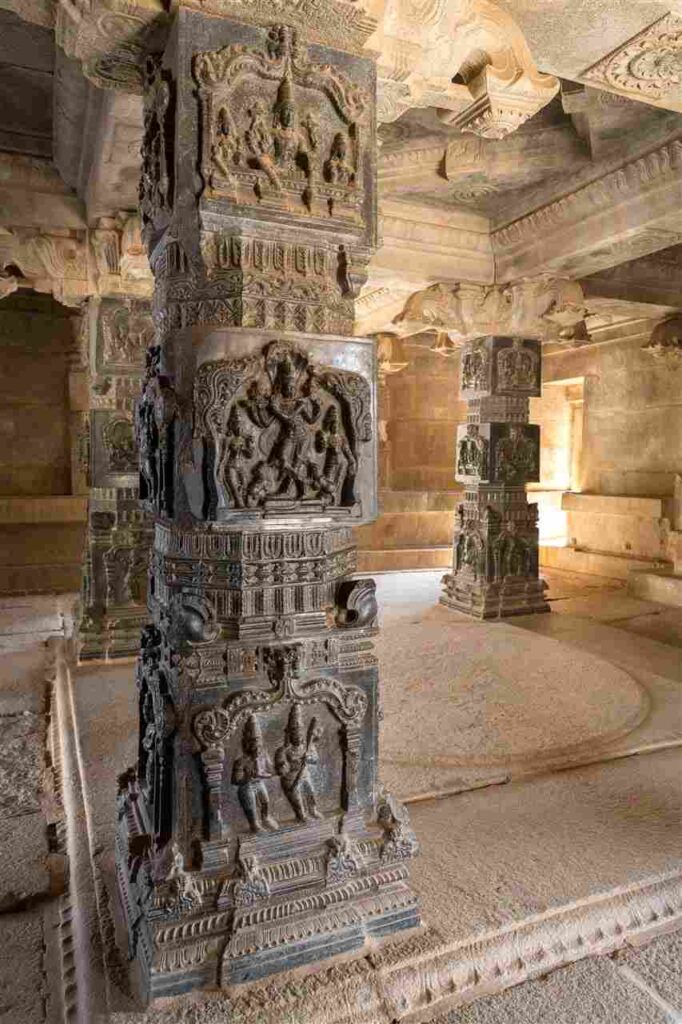
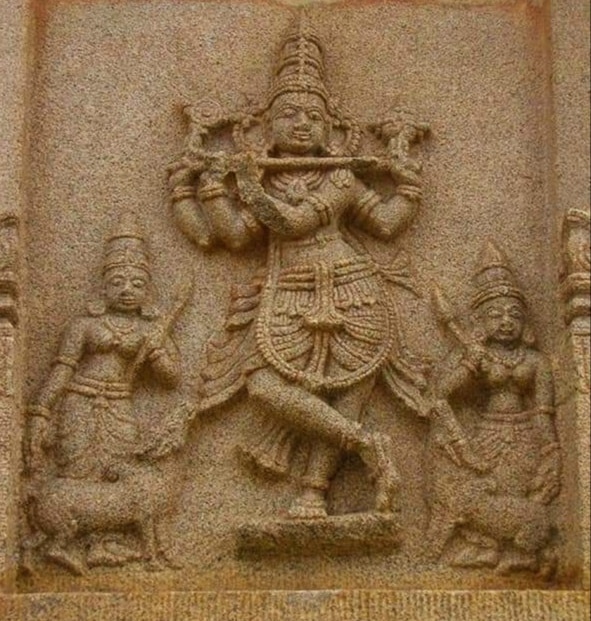
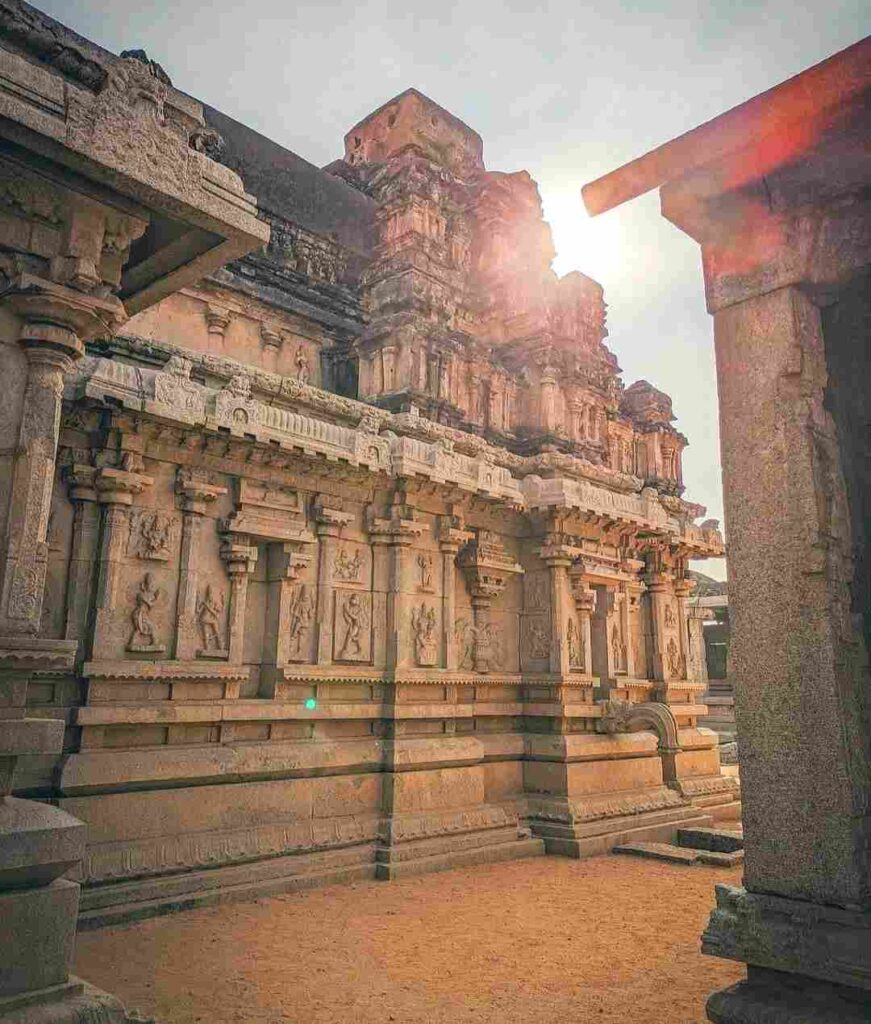
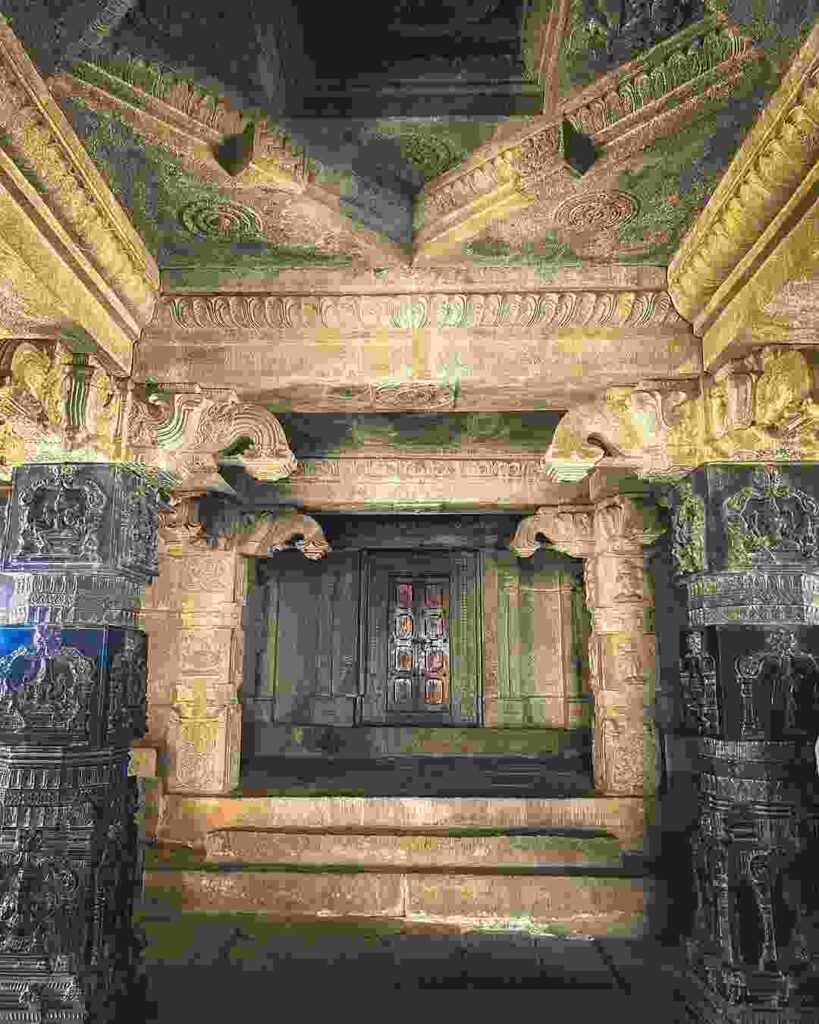
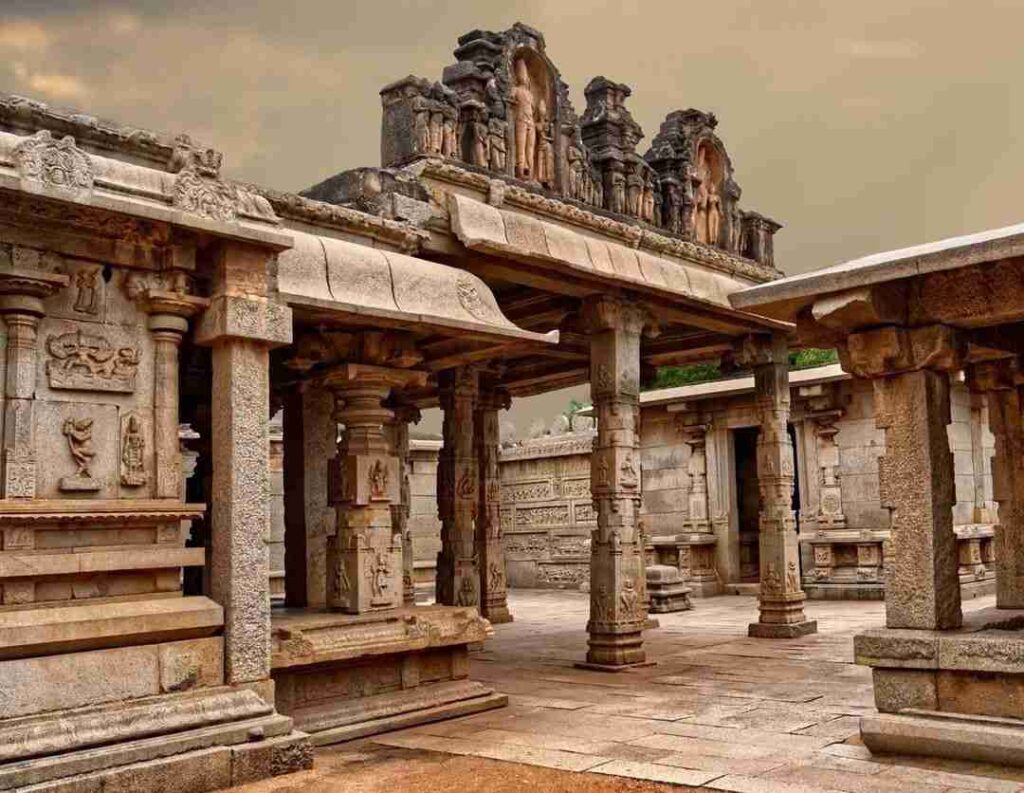

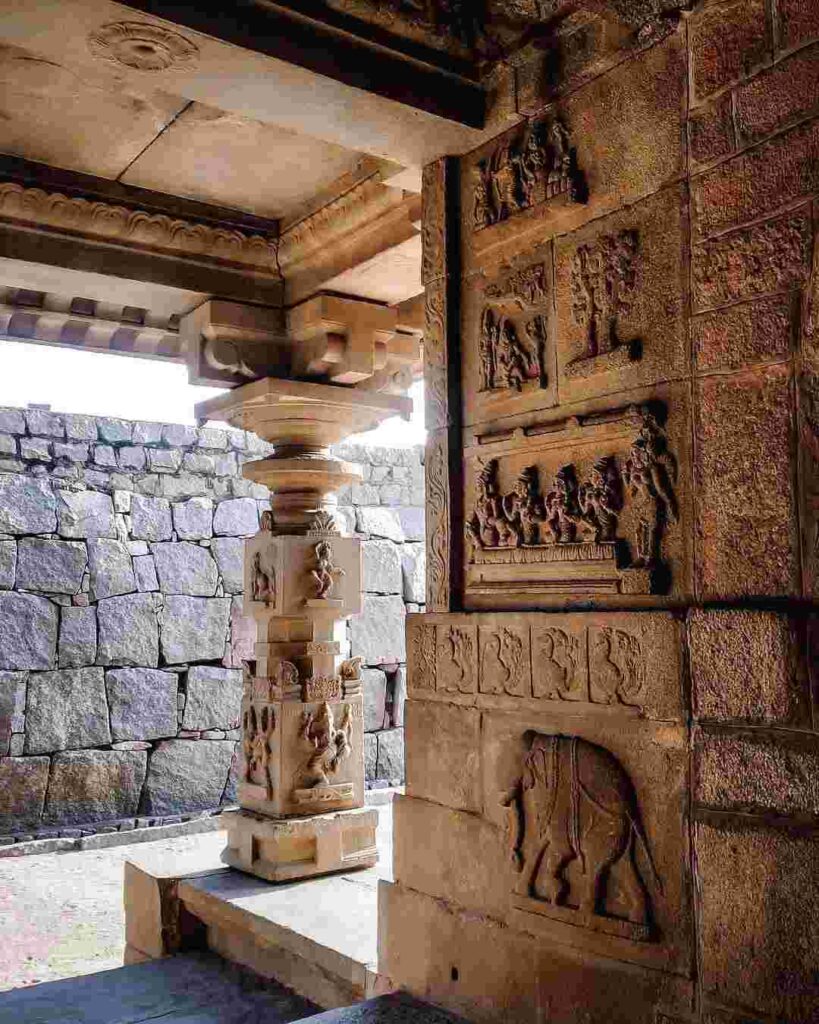
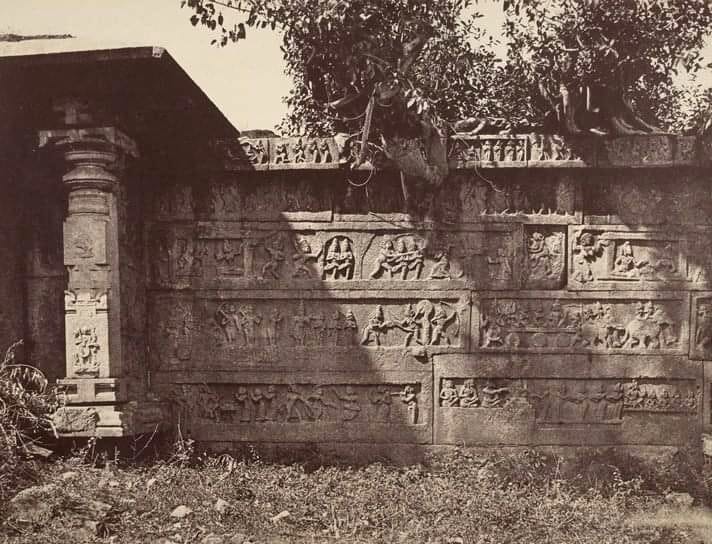
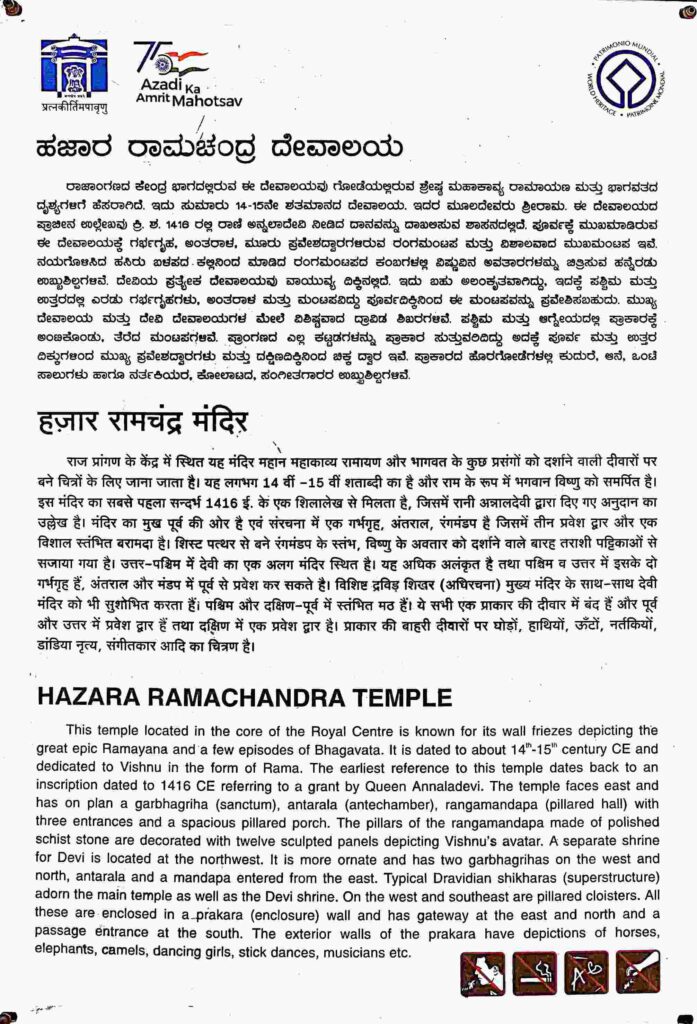
References:-
References from the Following Sources;
- ^[1] – ASI information plaque about Hazara Rama Temple
- ^[2] – Hazara Rama Temple – Karnataka Tourism